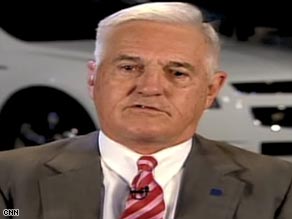AOL Autos) -- You don't have to look too far into the past to find a time when automakers didn't see car safety as a "selling point." But over the last 30 years, car safety has become a prime factor in the minds of car buyers.

The NHTSA ranks the Volkswagen Jetta as one of the top safest small cars.
So, automakers responded -- and as a result, cars and trucks are much safer today than they were 30, 20, even 10 years ago.
One car segment that has especially benefited from this overall improvement in safety is the sub-compact category. And it's a good thing, too, because as gas prices have soared in the last two years, more buyers are turning away from big trucks, monster SUVs and gas-thirsty muscle cars in favor of smaller, more fuel-efficient vehicles.
Indeed, the small-car category is the fastest-growing segment in the U.S. auto industry, with sales increasing by 12 percent this year, and everyone expects that growth to continue as long as gas prices keep rising -- or even if they just hold steady and don't drop. That's why many automakers have even more sub-compact models in their product pipelines.
So, as Americans' buying preferences have shifted to smaller vehicles, the old debate about the safety of small cars has ignited anew. Some drivers who've been in an SUV for the last six years have been apprehensive about not being surrounded by a massive steel structure and a few dozen feet of sheet metal.
But those who have been forced to "go small" for economic reasons can take comfort in the fact that small cars are much safer today than they were just a decade ago. AOL Autos: Cars with the lowest ownership costs
According to the most recent available data released by the Insurance Institute for Highway Safety (IIHS), the death rate in the smallest cars on the road has dropped to 106 per million registered vehicles, a significant drop from the 165 per million in 1996.
And today, 14 of the 17 top-selling small cars receive good frontal crash test ratings from IIHS, says Adrian Lund, IIHS president. A decade ago, none did. "That's obviously a huge improvement," stresses Lund. "Small cars are indeed much safer now than they were just a decade ago."
The IIHS is a non-profit group, funded by auto insurers, that conducts research on "how to prevent damage and injuries and deaths" in auto accidents, says Lund. AOL Autos: Most popular fuel-efficient cars
"There have been many new technological developments over the last 10 years, and all small cars now have front air bags, many of them have side air bags with head prevention, and many are getting electronic stability control," Lund continues.
"Plus, due to the crash testing conducted by us and by the National Highway Transportation & Safety Administration (NHTSA -- a division of the Department of Transportation), many of the automakers have improved the structural design of the passenger compartment -- which means there is less 'intrusion' into the compartment than there used to be if a crash occurs."
Here are six of the safest small cars on the road, according to NHTSA, which gave all six a frontal-crash-test rating of five stars, the organization's highest rating. AOL Autos: Safest small cars
Ford's small-car entry, the Focus, followed right behind these models, as far as NHTSA is concerned, with a four-star frontal-crash-test rating.
IIHS uses a different system of rating vehicles' crash-test results than NHTSA. And to illustrate the improvement in small-car safety, IIHS compared some current models to older models from the same car maker.
The current Chevy Cobalt, for example, got a "good" overall frontal-crash test rating from IIHS -- the organization's highest rating. Comparatively, the old Chevy Cavalier, which was produced from 1995 - 2005, received a "poor" overall frontal-crash rating. AOL Autos: Four fast cars for under $30,000
"The overall frontal rating," explains IIHS spokesman Russ Rader, "is based on the individual scores for each of the parameters we measure in the test -- such as the performance of the vehicle's structure; injury measures to the head, neck, chest, legs and feet, and the dummy's movement during the test."
Meanwhile, the old Dodge Neon (1995-'99) received a "poor" overall frontal rating, while its replacement, the current Dodge Caliber, scores a "good" rating from IIHS. AOL Autos: Best-selling small cars
And according to IIHS results, the Ford Focus's frontal-offset crash-test results have remained steady -- it received a "good" rating in that category from 2000-'08, although its 2000-'07 models received a "poor" rating when it came to side-impact tests when tested without the optional side airbags.
One car company that has emphasized the safety of small cars in recent years is Honda, which launched its "safety for everyone" initiative in 2003. As part of this initiative, the company announced the development of Advanced Compatibility Engineering (ACE) body structure, which bolstered occupant protection.
"The 2009 Fit will be the latest small model to get ACE when it goes on sale in the next couple of months," says company spokesman Chris Martin. "With the intro of the new Fit, over 94% of Honda's sold in the U.S. will have the Advanced Compatibility Engineering technology."
A couple of years ago, automakers also adopted an initiative that will improve the safety for small-car drivers by agreeing to build trucks and SUVs with lower front ends.
"This should address the incompatibility between cars and trucks, says Lund. "Trucks have always ridden higher than cars -- which makes them inherently more dangerous to drivers of smaller cars in the event of an accident. So, by next year, we'll be seeing light trucks with lower structures," says Lund.
"In the event of an accident, that means that the front end of the truck will hit the bumper or door sill of the car, instead of hitting the car higher up, like in the passenger compartment, which in the past, has made drivers of small cars much more vulnerable to injury."
But, even though small cars have made big safety gains, it is true that big vehicles are still safer than small ones.
"The risk of dying in the smallest car, compared to the largest car, is still 2-to-1," says Lund. "But, now that people are being forced to make the switch to smaller vehicles due to economic considerations, with fuel prices being so high, it's a comfort for them to know that the smallest cars are so much safer than they were 10 years ago."
The current trend toward buying smaller vehicles also prompts Lund to point out that, "if you do want or need to go with a smaller car, it is important to pay attention to its crash-test ratings."






Comment On This Story